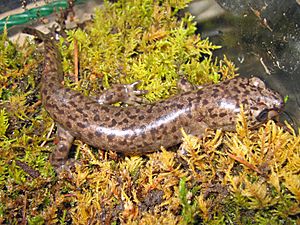Pacific giant salamander facts for kids
Quick facts for kids Pacific giant salamanders |
|
|---|---|
 |
|
| Dicamptodon tenebrosus | |
| Scientific classification |
|
| Kingdom: | Animalia |
| Phylum: | Chordata |
| Class: | Amphibia |
| Order: | Urodela |
| Family: | Ambystomatidae |
| Genus: | Dicamptodon Strauch, 1870 |
A Pacific giant salamander (Dicamptodon) is a really big type of salamander. These amazing amphibians are known for their large size. They are also one of the few salamanders that can make sounds!
Contents
Pacific Giant Salamanders: Amazing Amphibians
What Are Pacific Giant Salamanders?
Pacific giant salamanders belong to a special group, or genus, called Dicamptodon. A genus is a way scientists group similar animals together. They are part of the larger salamander family.
These salamanders can grow quite large. Some can reach up to 30 centimeters (about 12 inches) long. That's about the length of a school ruler!
Where Do They Live?
You can find Pacific giant salamanders in the Pacific Northwest region of North America. This area includes parts of the United States and Canada. They prefer cool, moist places.
They often live near streams, rivers, and damp forests. This helps them stay hydrated and find food.
Unique Abilities
Most salamanders are very quiet creatures. However, Pacific giant salamanders are different. They can actually make noises! This is quite rare for a salamander.
Adult Pacific giant salamanders are also special because they can live in two different places. They can live on land, usually in damp areas under logs or rocks. They can also live in water, like streams and ponds.
Different Kinds of Giant Salamanders
There are four different species, or types, of Pacific giant salamanders. Each one is a little bit different and lives in specific areas:
- Cope's giant salamander (D. copei)
- Idaho giant salamander (D. aterrimus)
- Coastal giant salamander (D. tenebrosus)
- California giant salamander (D. ensatus)
Each of these species plays an important role in its local ecosystem. They help keep insect populations in check.
See also
In Spanish: Dicamptodon para niños


